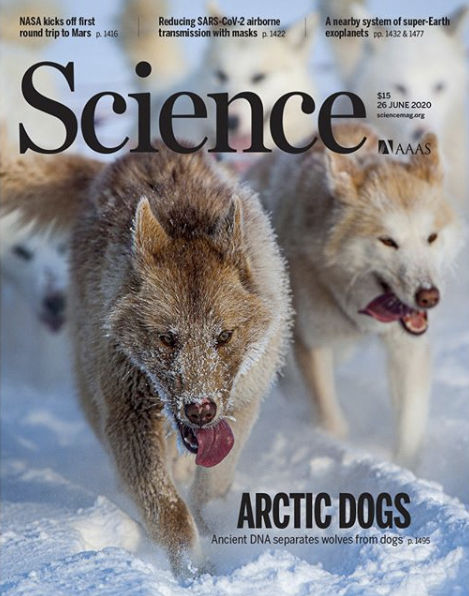Greenland Sled Dogs are closely related to old ‘Ancient Dog’
- Carsten Egevang
- Jun 25, 2020
- 4 min read
Updated: Nov 30, 2020
Greenland sled dogs are much older and have adapted to Arctic conditions much earlier than previously thought. In a new study from the Qimmeq project, researchers show that ancestors of modern sled dogs have worked and lived with humans for over 9,500 years.
Cover image by Carsten Egevang on SCIENCE, June 2020
Dogs play an important role in human life all over the world – whether as a family member or as a working animal. But where the dog comes from and how old various groups of dogs are is still a bit of a mystery.
Now, light has been shed on the origin of the sled dog. In a new study published on the cover of SCIENCE magazine, illustrated with a photo by Carsten Egevang, show that the sled dog is both older and has adapted to the Arctic much earlier than thought. In the academic sphere of natural science, SCIENCE magazine is the world’s most high-ranking out-put of research results.
On the cover …
Science magazine is the World’s leading magazine on natural sciences and regarded as one of the most prestigious journals for researchers to publish their research results. Only the most novel and ground-breaking research results will get accepted into SCIENCE – yet alone make is as the lead story on the cover of the magazine.
The research paper “Arctic-Adapted Dogs Emerged at the Pleistocene-Holocene Transition” was published in SCIENCE on June 26, 2020 using the image “THE LEADER OF THE PACK” from Ilulissat, West Greenland. The image was shot in 2014 when Carsten Egevang joined local hunters on a 4-day dog sled trip for hunting into the interior parts of Ilulissat Icefjord UNESCO World Heritage Site. On the trip, temperatures dropped rapidly, freezing icicles on the dog’s fur. As one of the sledges were about to pass the sled with Carsten on it, he took off his gloves despite the bitter cold and went for his camera to capture this amazing photo.
Click on the image to view SCIENCE "Visuel Blog" about sled dog photography.
Ancient DNA study
‘We have extracted DNA from a 9,500-year-old dog from the Siberian island of Zhokhov, which the dog is named after. Based on that DNA we have sequenced the oldest complete dog genome to date, and the results show an extremely early diversification of dogs into types as sled dogs’, says first author of the study, Mikkel Sinding, the Globe Institute, University of Copenhagen.
Until now, it has been the common belief that the 9,500-year-old Siberian dog, Zhokhov, was a kind of ancient dog – one of the earliest domesticated dogs and a version of the common origin of all dogs. But according to the new study, modern sled dogs such as the Siberian Husky, the Alaskan Malamute and the Greenland sled dog share the major part of their genome with Zhokhov.
‘This means that modern sled dogs and Zhokhov had the same common origin in Siberia more than 9,500 years ago. Until now, we have thought that sled dogs were only 2-3,000 years old’, says Mikkel Sinding.

Carsten Egevang collects DNA samples from Greenland Sled Dogs in Uummannaq during one of the photo expeditions conducted by The Qimmeq Project.
The Original Sled Dog To learn more about the origins of the sled dog, researchers have further sequenced genomes of a 33,000-year-old Siberian wolf and ten modern Greenlandic sled dogs. They have compared these genomes to genomes of dogs and wolves from around the world.
‘We can see that the modern sled dogs have most of their genomes in common with Zhokhov. So, they are more closely related to this ancient dog than to other dogs and wolves. But not just that – we can see traces of crossbreeding with wolves such as the 33,000-year-old Siberian wolf – but not with modern wolves. It further emphasises that the origin of the modern sled dog goes back much further than we had thought’, says Mikkel Sinding.
The modern sled dogs have more genetic overlap with other modern dog breeds than Zhokhov has, but the studies do not show us where or when this occurred. Nevertheless, among modern sled dogs, the Greenland sled dogs stands out and has the least overlap with other dogs, meaning that the Greenland sled dog is probably the most original sled dog in the world.
Common Features with Inuit and Polar Bears In addition to advancing the common understanding of the origin of sled dogs, the new study also teaches the researchers more about the differences between sled dogs and other dogs. Sled dogs do not have the same genetic adaptations to a sugar and starch rich diet that other dogs have. On the other hand, they have adaptations to high-fat diets, with mechanisms that are similar to those described for polar bears and Arctic people.
‘This emphasises that sled dogs and Arctic people have worked and adapted together for more than 9,500 years. We can also see that they have adaptations that are probably linked to improved oxygen uptake, which makes sense in relation to sledding and give the sledding tradition ancient roots’., says Mikkel Sinding.



Comments